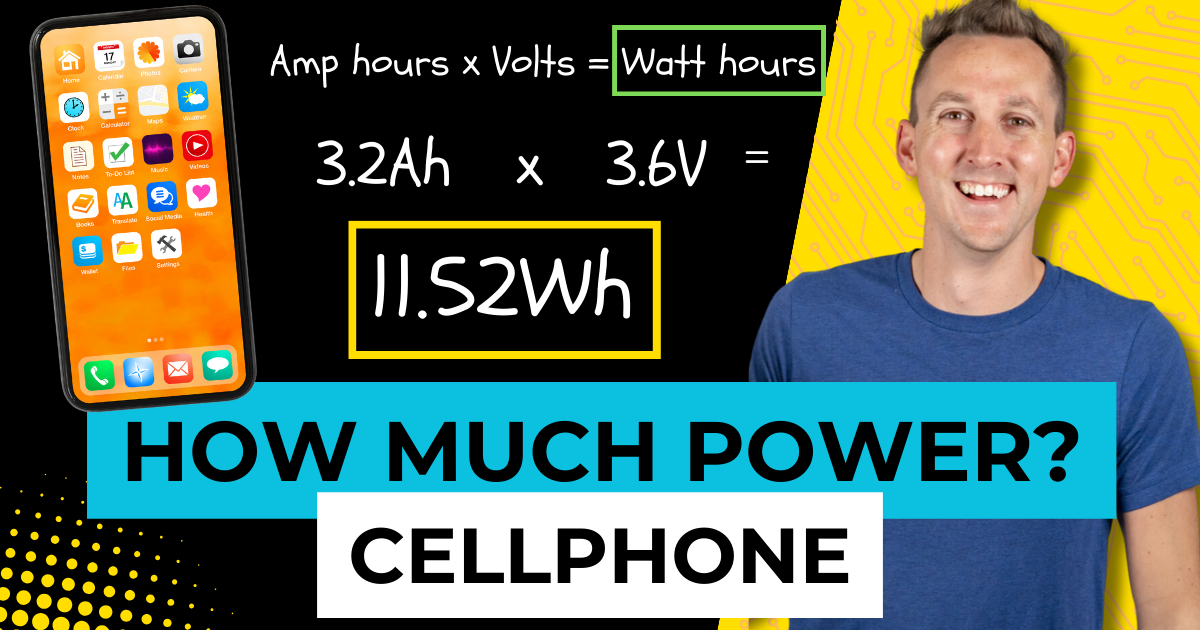Phones are important for checking emails, making calls, and sending texts and If we plan on re-charging our phones from an off-grid electrical system, we need to know how much power they will use on a day-to-day basis so we can size our batteries and solar appropriately.
Now the methods for estimating power usage I’m going to teach you will work for many other hand-held devices as well, like Bluetooth speakers, drones, cameras, and essentially anything else that has a battery inside of it and is powered by USB.
So if you keep an open mind and think critically, you’ll be able to apply this information to your own specific project.

In episode 2.1, I showed you how to figure out how much power a coffee maker used to brew a pot of coffee and keep it warm for an hour by using one of these energy meters; and after a little bit of testing, honestly, it doesn’t work that good for determining how much power a phone uses.
It shows how much power is going into the phone while actively re-charging; but when the battery was full, and I was just sitting here using it; no power was flowing to operate the phone while the battery was full; which was admittedly not what I expected.

I tested the same thing with this portable speaker with the same result, so I came up with a better and more predictable plan for power estimation. Here’s what we’re going to do.
1: We figure out how big the battery inside of the device is.
2: We convert that to watt hours.
3: We figure out how many times per day we would be recharging the device.
4: Multiply the device’s battery size times the number of times we recharge the device per day.
That’s the plan; and here’s how it looks.
I have an iPhone 15 pro and the first thing I’m going to do is look on the phone or in the phone’s settings to see if the watt hours, mAh, or battery voltage is listed, which in this case, there is nothing listed and I’m sure it’s printed on the actual battery itself; but since I can’t get to the battery easily, we have to resort to looking it up.
Google Searches of:
- Iphone 15 Pro Battery Capacity
- Iphone 15 Pro Watt Hours
- Iphone 15 Pro battery mAh
- Iphone 15 Pro battery voltage
Should get you what you need.
Ideally, you’ll be able to find a source that tells you how many watt hours the battery has in it; and if that’s the case, we are finished and we have our answer. In my case, I’m finding a source claiming a 12.7Wh battery for my phone.

If I hadn’t been able to find that, I would need the mAh or the Ah and the battery voltage. This article says that the Iphone 15 Pro has a 3,274mAh battery. Converting this from mAh to Ah is as simple as moving the decimal three places to the left, dividing by 1,000, or googling mAh to Ah and entering your values.

From there, we’ve found this article that says that iphone batteries are about 3.6V; which means we can use Amp Hours x Volts = Watt Hours to determine that: 3.2Ah x 3.6V = 11.52 Watt hours, which is pretty close to the 12.7 Watt Hours listed earlier.

Now that we know our phone battery has 12.7 watt hours inside of it, we just need to know how many times per day we are going to recharge it.
Personally, I pretty much always re-charge my phone at night while I’m sleeping so it’s ready to go in the morning and I rarely have to re-charge it throughout the day, but by the end of the day, it’s fairly close to empty. 10-20% or so.
For easy math, I’m going to say that I use the full battery, every day; which means that I use 12.7 Watt Hours every day to keep my phone operational.
If I had a device that I consistently only used to 50%, it is easy to just take that 12.7 Watt Hours and divide it by two.
If I had a device I used in the morning, recharged it, then used it again in the evening, and then recharged again overnight, that would be two charges per day, so I’d multiply 12.7 Watt Hours by two.

So, in short, When I’m trying to size an off-grid electrical system and am doing a power audit, I’ve found it easiest to just figure out how many times I was recharging a device per day and multiply by its internal battery size.
In the context of recharging a phone from a larger off-grid battery bank, here’s how that would look:
12.7 watt hours pulled from a 12V battery bank would be a loss of 1.06 amp hours, or 1.06% being drawn from a 100Ah battery, per charging cycle of the phone, not counting any kind of inverter efficiency losses.

So… very minimal power consumption here, but still worth noting when you are doing power audits for off grid electrical systems as these small, seemingly insignificant loads can add up quickly, especially when you have multiple of them.
Now you should have a good idea of how to calculate the power used by a cell phone in a mobile, marine, or off-grid electrical system; and you can use these principles to figure out the power usage of many other items like bluetooth speakers, drones, cameras and more.



